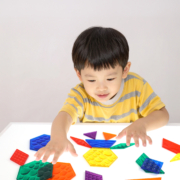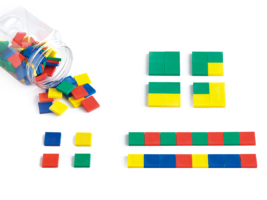Patterns in Play: Building the Foundations of Maths and STEM Learning
Patterns are everywhere on the wings of a butterfly, in the rhythm of music, or in the colorful designs children create during play.
What may look like simple fun is actually a powerful foundation for mathematical thinking. Recognizing, copying, and creating patterns helps children make sense of the world around them and build essential early learning skills.
At Edx Education, we believe that children learn best through hands-on, play-based exploration. Our educational toys like Pattern Blocks, Rainbow Pebbles®, and GeoStix® are designed to inspire curiosity, creativity, and confidence while supporting early years maths and STEM learning.
The Importance of Pattern Recognition in Early Childhood
Pattern recognition is one of the first steps in developing logical and mathematical reasoning. From an early age, children begin to notice and repeat sequences like clapping rhythms or arranging objects in order. These experiences teach them about sequencing, prediction, and order, which later form the basis of counting, addition, and problem-solving.
When a child identifies a pattern such as red-blue-red-blue, they’re learning to predict what comes next a vital part of early mathematical understanding. As they grow, this awareness helps them recognize numerical patterns, symmetry, and relationships between numbers and shapes.
Pattern play also strengthens memory, focus, and critical thinking. By experimenting with different shapes, colors, and sequences, children learn to make connections, test ideas, and solve problems creatively.
Connecting Patterns to Art, Rhythm, and Nature
Patterns are not just about maths they’re part of art, music, and the natural world. Encourage children to explore patterns in nature, such as flower petals, shells, and animal markings. These real-world observations help children connect abstract mathematical ideas to their environment.
Music and rhythm also offer rich opportunities for pattern learning. Clapping or drumming in repeated beats teaches sequencing, timing, and coordination. Similarly, art and design activities—like making repeating shape patterns with Pattern Blocks or arranging Rainbow Pebbles® into mandalas—blend creativity with mathematical learning.
When children use GeoStix®, they can explore lines, angles, and symmetry while creating patterns and geometric shapes. Through these open-ended activities, they’re developing early STEM skills in a playful, engaging way.
Play Ideas to Explore Patterns
Here are some simple and inspiring ways to encourage pattern recognition at home or in the classroom:
- Pattern Sorting: Use Rainbow Pebbles® or household items to sort by color, size, or shape. Encourage children to make their own repeating patterns and challenge them to extend or change the sequence.
- Shape Creations: Build pictures using Pattern Blocks like houses, animals, or flowers then discuss the repeating shapes or colors. This builds early geometry and design awareness.
- GeoStix® Design Challenge: Invite children to connect GeoStix® into lines and angles, experimenting with symmetry and repetition. Ask them to describe the patterns they’ve made.
- Sound and Movement Patterns: Create rhythmic sequences through clapping, drumming, or dancing. Patterns in sound and movement help reinforce sequencing, timing, and coordination.
- Nature Patterns: Go outside and explore! Look for natural patterns—like leaves, clouds, or waves. Encourage children to draw what they find and replicate the patterns using Rainbow Pebbles® or Pattern Blocks.
Patterns Build a Foundation for STEAM Learning
Through playful experiences with patterns, children learn to observe, predict, and make sense of relationships skills that are essential for STEAM education. Pattern recognition forms the building blocks for mathematical and scientific reasoning, helping children grow into confident problem solvers and creative thinkers.
At Edx Education, we create high quality educational toys and resources designed to make learning through play engaging and meaningful. Our award-winning toys, global learning resources, and Play, Learn & Create with Edx Education podcast all celebrate the importance of play in building lifelong learners.
When children explore patterns whether through colour, rhythm, or design they’re not just playing. They’re unlocking the foundations of maths, creativity, and critical thinking for life.
Written by Heather Welch, Edx Education UK General Manager and author of Happy Children Play

 Edx Education
Edx Education


 Edx Education
Edx Education